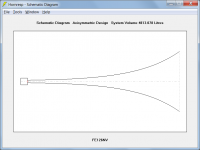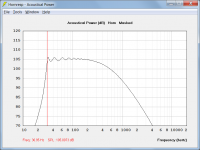I just finished the Fostex BK-12m (Madisound kit), which was a blast. With just a few hours I am loving it and if they improve with break-in I will be in for even more of a treat.
I was wondering - if you had no limitations of space, budget, could you make the horn even larger and get even more bass performance from the same driver (FE126NV in this case)? For the kit I built, the horn is about 6x14" and F3 is rated at 65 Hz. If you had a (properly designed) horn with a 2x, 4x larger opening, could you get even more usable low-frequency response? Or is this driver maxed out in this cabinet?
Thanks!
I was wondering - if you had no limitations of space, budget, could you make the horn even larger and get even more bass performance from the same driver (FE126NV in this case)? For the kit I built, the horn is about 6x14" and F3 is rated at 65 Hz. If you had a (properly designed) horn with a 2x, 4x larger opening, could you get even more usable low-frequency response? Or is this driver maxed out in this cabinet?
Thanks!
I suspect it'd be possible to get more LF output and/or extension.
Sounds like now's the time for you to pick up Hornresp and start playing around.
Chris
Sounds like now's the time for you to pick up Hornresp and start playing around.
Chris
I was wondering - if you had no limitations of space, budget, could you make the horn even larger and get even more bass performance from the same driver (FE126NV in this case)?
Valiant, from the same designer as the BK12m.
Woden Design | Valiant

dave
Interesting. Each horn opening appears to be fairly similar in size of what I have...but of course there are two of them. Does having two identical horns lower the frequency response, or just improve efficiency (more bass, but not lower bass)?
For example this sort of thing...a MASSIVE horn exit. If you used the FE126NV in a similar design, could you get usable extension down even lower?

For example this sort of thing...a MASSIVE horn exit. If you used the FE126NV in a similar design, could you get usable extension down even lower?

LOL, you beat me to it! Thanks for the PDF, great info. I know who Nelson Pass is (amps!) but didn't know he was into speakers to that degree.
Nelson has done a bit on full range open baffles.
With respect to the horns there's an article where his team goes through a whole bunch of drivers and proposes compensation networks for each. I think it was in relation to current amps. Take a look at the site and peruse.
With respect to the horns there's an article where his team goes through a whole bunch of drivers and proposes compensation networks for each. I think it was in relation to current amps. Take a look at the site and peruse.
Interesting. Each horn opening appears to be fairly similar in size of what I have...but of course there are two of them. Does having two identical horns lower the frequency response, or just improve efficiency (more bass, but not lower bass)?
Both. it doesn’t actually improve efficiency since that is fixed by the front radiation, but gives more gain in the bottom (which depending on room, room placement and taste may need to be dialed back a bit [can be done with damping]). The rear mouth uses the room to enlarge the size effective size of the mouth and how low a horn can go is directly related to the size of the mouth. A larger mouth also usually needs a longer horn.
dave
I was wondering - if you had no limitations of space, budget, could you make the horn even larger and get even more bass performance from the same driver (FE126NV in this case)?
It's a function of the driver's upper/lower mass corner function:
Flc = Fs*Qts'/2
Fhm = 2*Fs/Qts'
Qts' = Qts + any added series resistance [Rs]: HiFi Loudspeaker Design
Below/above these points there's nothing to drive it, so > an acoustical 1/2 WL [horn + boundary loading] can only sum with any room gain down below the horn's low corner [Flc] like for instance some 'BIB' pipe horn alignments in large rooms.
GM
I was wondering - if you had no limitations of space, budget, could you make the horn even larger and get even more bass performance from the same driver (FE126NV in this case)?
Attachments
Thanks!
If I am reading that correctly, 53,000 cm^2 horn opening, which is 230 x 230 cm and plays down to ~31 Hz? Is that 105 dB the sensitivity at 1 watt or max theoretical output of the driver (with 15/45 watt sustained/peak input)? Wow.
In 1/2 space, such as setting on/perpendicular to, a billiard table flat field outdoors, so a 1/2 size terminus [mouth], which in a room size typical of such a horn its response will be anything but flat due to its room modes.
1 W, so your 'full range' driver is now a woofer horn driver with an upper useful BW = its Fhm = ~465 Hz before accounting for real world losses that DMB left at Rg = 0.00, so will be [somewhat] lower in reality, but its academic since the driver's low Xmax will limit it to just a fraction of a watt down low, i.e. historically required a 'flea power' tube amp to both power and protect it.
GM
1 W, so your 'full range' driver is now a woofer horn driver with an upper useful BW = its Fhm = ~465 Hz before accounting for real world losses that DMB left at Rg = 0.00, so will be [somewhat] lower in reality, but its academic since the driver's low Xmax will limit it to just a fraction of a watt down low, i.e. historically required a 'flea power' tube amp to both power and protect it.
GM
you would have to EQ as the horn LF is a good 10dB louder than the mids of the direct radiator ? a smaller but still sizable horn::


also an interesting comparison of Pluvia in that blh above vs the University Classic folded flh with Kappa15C and only about
half the path length of the blh.

half the path length of the blh.

With a EQ, would you run out of cone movement pretty quick? I could see it to knock down peaks, if that was a consequence of using a different horn design.
Either way, thanks, very interesting.
Either way, thanks, very interesting.
from what I see with a large BLH, the rear horn loaded portion /LF to upper bass portion of the total output is ~10dB better than the direct radiator side so that area would be shelved down about 10dB. EQ-ing below below the back loaded horn's cutoff (~where the cone excursion rises rapidly) might not be practical for some drivers. Maybe room gain alone would add some extension.
( maybe Nelson Pass will notice your thread and give practical pointers)

( maybe Nelson Pass will notice your thread and give practical pointers)

you would have to EQ as the horn LF is a good 10dB louder than the mids of the direct radiator ?
HR 'says' the 126NV's mid-band eff. = ~91.27 dB/m, then add 3-6 dB for BSC, so shelving between 7.73 - 10.73 dB.
GM
EQ-ing below below the back loaded horn's cutoff (~where the cone excursion rises rapidly) might not be practical for some drivers.
EQ boosts below the lower cutoff of a tuned cabinet should always be avoided.
Below Fb (whether it's ported, BLH, TH, whatever), excursion rises while output drops. As a result, distortion rises very quickly, and you risk driver damage in some situations.
If more LF extension is desired, it's best to alter the cabinet to suit. Most of my home-HiFi applications are relatively low SPL, so I go with sealed boxes and EQ the result.
Chris
With a EQ, would you run out of cone movement pretty quick? I could see it to knock down peaks, if that was a consequence of using a different horn design.
Either way, thanks, very interesting.
Depends what you're using the EQ for.
If you're trying to get another octave of LF extension, then cone excursion is something to keep in mind. Adjusting the LF shape by a dB or two? I don't think I'd even check.
IMO, so long as your drivers will be in their linear region (NB - the Fostex full-range drivers are effectively even-hung motors, so can be driven way past their theoretical Xmax with little degradation to the sound) at your desired SPL and target LF cutoff, you'll be fine.
Chris
- Home
- Loudspeakers
- Full Range
- How big of a back-horn would be usable for a 4-5" FR driver?


